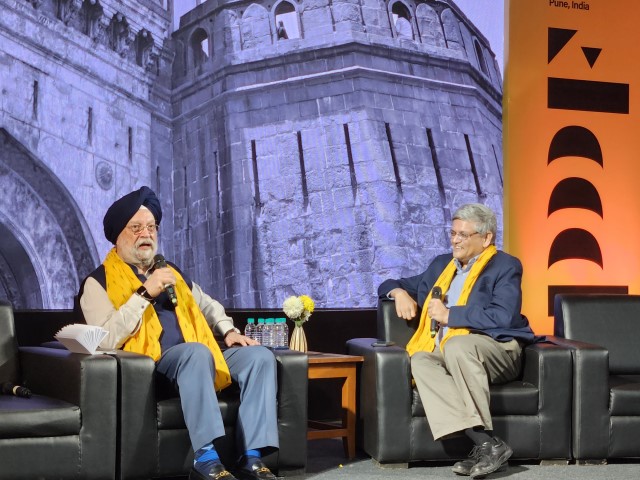
PUNE: Urbanization and energy requirements were neglected by the previous governments. The focus was more on rural development with the vision of India living in villages. With migration starting to urban and semi-urban cities for job opportunities, the economic calculation started going wrong since the previous governments did not have the urban policy in place, opined Hardeep Singh Puri, Union Minister for Housing and Urban Affairs, Petroleum and Natural Gas during the concluding session of the first edition of the Pune Public Policy Festival at Gokhale Institute of Politics and Economics.
The festival was organized by Sahil Deo and was supported by the Parimal and Pramod Chaudhari Foundation. The first edition of the festival received a warm response from the students and entrepreneurs. Ajit Rande, VC, Gokhale Institute, Indranil Chitale, Siddharth Desai, and Rugwed Deshpande were present for the concluding ceremony.
In his speech, Puri said, “The cumulative spent on urban space by the central government was about 1,57,000 Cr between 2004 and 2014. After 2014, we realized the challenges in urbanization and we saw an opportunity in it. Thus, the current government has increased it by 11 times and today we are spending about 18 Lac Cr for this purpose. This expenditure was necessary because 65% of India’s GDP comes from the urban population. Now, we do have a trade-off. Simplistically putting it, Can we make one choice between growth or being environmentally conscious? The answer is we have to do both. This is why the Prime Minister declared the entire year as the Global Housing Technology Challenge Year.
“Under this initiative, we invited all universities and companies to come to India to demonstrate green technologies. Out of these, we shortlisted 53 technologies which became the operating Bible. From these 6 more technologies were shortlisted for 6 lighthouse projects, that is 6 projects of 1000 residential units each in one year using the most green technology. 4 Cr houses are being made under the Pradhan Mantri Awas Yojana of which 1.9 Cr are in urban spaces“
“Buildings and transport cause pollution. Today we have a position where over 60 million people go to Petrol Pumps to fill up fuel. India’s rate of growth in fuel demand is 3 times more than the global average. In the next 20 years, 25% of the increase in global demand is going to come from India. So to deal with this situation we are addressing the trilemma of availability, affordability, and sustainability. Our ENP (Exploration and Production) is increasing. We have a 3.5 million square kilometer sedimentary basin. We opened up 1 million sedimentary basins which were no-go areas. We opened it up to exploration. Now we have gone from production sharing to revenue sharing contracts with oil exploration companies. We have also gone to the extent of incentivizing the finance for exploration. Currently, 87% of fuels are imported of which roughly 45% is crude and 45 % is natural gas“, Puri informed.
He appraised the gathering about the positive sentiment at the recent summit held at Davos where the world is looking at the growth potential of India. He said that there is a lot of buzz about the Global Biodule Alliance about the scaling up of the Sustainable Aviation Fuel since the European Governments are going to make it compulsory. Three years before we were discussing about 1 car could be an electric one in 25 cars. Today we are talking about 1 car as electric in 5 cars. So, the world is changing to alternate fuel. Now, we have achieved 12% ethanol blending from a mere 1.4 % in 2014. The target now is 20% by 2025. This blending not only saved an import bill of 41000 Cr but also helped us to pay the farmers over 42000 Cr from the production of ethanol. Second-generation biofuels are now being made from agricultural waste so the issue of food security gets answered effectively.
The minister informed that the Government is looking at 1% blending in Sustainable Aviation Fuel by 2027, 3% by 2028, and 5% by 2029. This will lead to more need and production of ethanol. The requirement even at 1% blending will be 14 thousand Cr liters of biofuel. According to him, Green Hydrogen Fuel can be a success in India. He concluded by saying as per the report of a foreign agency urban spaces in India are increasing at a rapid rate and thus we see a huge construction activity happening in the country. So, the country will take energy and urbanization with a focus on finding a sustainable cost-efficient way.
